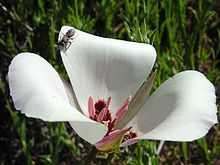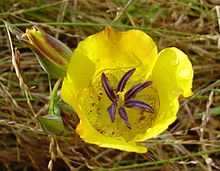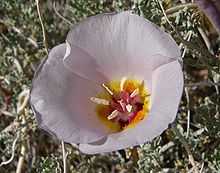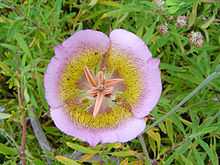Calochortus
| Calochortus | |
|---|---|
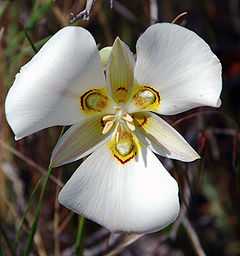 | |
| Sego Lily Calochortus nuttallii | |
| Scientific classification | |
| Kingdom: | Plantae |
| (unranked): | Angiosperms |
| (unranked): | Monocots |
| Order: | Liliales |
| Family: | Liliaceae |
| Subfamily: | Calochortoideae |
| Genus: | Calochortus |
| Type species | |
Calochortus /ˌkælɵˈkɔrtəs/[1] is a genus of plants that includes herbaceous, perennial and bulbous species, all native to North America.
The genus Calochortus includes Mariposas (or Mariposa lilies) with open wedge-shaped petals, Globe lilies and Fairy lanterns with globe-shaped flowers, and Cat's ears and Star tulips with erect pointed petals. The word Calochortus is derived from Greek and means "beautiful grass".
Description
Calochortus produce one or more flowers on a stem that arises from the bulb, generally in the spring or early summer. Unlike most other Liliaceae, Calochortus petals differ in size and color from their sepals.[2] Flowers can be white, yellow, pink, purple, bluish, or streaked. The insides of the petals are often very 'hairy'. These hairs, along with the nectaries, are often used in distinguishing species from each other.
Species list
This list comprises the species native to North America, primarily but not exclusively to the Western United States.[3]
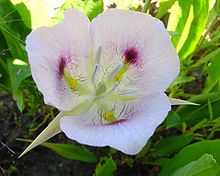
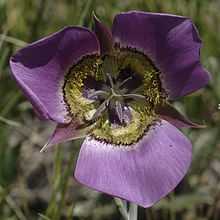
- Calochortus albus white globelily
- Calochortus amabilis short lily
- Calochortus ambiguus doubting Mariposa lily
- Calochortus amoenus purple globelily
- Calochortus apiculatus pointedtip Mariposa lily
- Calochortus argillosus
- Calochortus aureus golden Mariposa lily
- Calochortus barbatus yellow globe lily
- Calochortus bruneaunis Bruneau Mariposa lily
- Calochortus catalinae Santa Catalina Mariposa lily — (threatened by development)
- Calochortus clavatus clubhair Mariposa lily
- Calochortus clavatus var. avius -rare,
- Calochortus clavatus var. gracilis
- Calochortus clavatus ssp. clavatus
- Calochortus clavatus ssp. pallidus
- Calochortus clavatus ssp. recurvifolius — rare
- Calochortus coeruleus beavertail grass
- Calochortus concolor goldenbowl Mariposa lily
- Calochortus coxii Cox's Mariposa lily
- Calochortus dunnii Dunn's Mariposa lily — rare
- Calochortus elegans northwestern Mariposa lily; star tulip
- Calochortus elegans var. elegans elegant Mariposa lily
- Calochortus elegans var. nanus
- Calochortus elegans var. oreophilus elegant Mariposa lily
- Calochortus elegans var. selwayensis Selway Mariposa lily
- Calochortus eurycarpus white Mariposa lily
- Calochortus excavatus Inyo Mariposa lily — (threatened by groundwater development)
- Calochortus fimbriatus late-blooming Mariposa lily — rare
- Calochortus flexuosus winding Mariposa lily
- Calochortus greenei Green's Mariposa lily — rare
- Calochortus gunnisonii Gunnison's Mariposa lily
- Calochortus gunnisonii var. gunnisonii
- Calochortus gunnisonii var. perpulcher
- Calochortus howellii Howell's Mariposa lily
- Calochortus indecorus Sexton Mountain Mariposa lily
- Calochortus invenustus plain Mariposa lily
- Calochortus kennedyi desert Mariposa lily
- Calochortus kennedyi var. kennedyi
- Calochortus kennedyi var. munzii
- Calochortus leichtlinii smokey Mariposa
- Calochortus longebarbatus longbeard Mariposa lily
- Calochortus longebarbatus var. longebarbatus — (threatened by grazing)
- Calochortus longebarbatus var. peckii
- Calochortus luteus yellow Mariposa lily
- Calochortus lyallii Lyall's Mariposa lily
- Calochortus macrocarpus sagebrush Mariposa lily
- Calochortus macrocarpus var. macrocarpus
- Calochortus macrocarpus var. maculosus Nez Perce Mariposa lily
- Calochortus minimus Sierran Mariposa lily
- Calochortus monanthus Shasta River Mariposa lily — (presumed extinct)
- Calochortus monophyllus yellow startulip
- Calochortus nitidus broadfruit Mariposa lily
- Calochortus nudus naked Mariposa lily
- Calochortus nuttallii sego lily, (state flower of Utah)
- Calochortus obispoensis San Luis Mariposa lily
- Calochortus palmeri Palmer's Mariposa lily
- Calochortus palmeri var. munzii Munz's Mariposa lily
- Calochortus palmeri var. palmeri — rare
- Calochortus panamintensis Panamint Mountain Mariposa lily — rare
- Calochortus persistens Siskiyou Mariposa lily — rare
- Calochortus plummerae Plummer's Mariposa lily — rare
- Calochortus pulchellus Mount Diablo globelily
- Calochortus raichei Cedars Mariposa lily
- Calochortus simulans San Luis Obispo Mariposa lily
- Calochortus splendens splendid Mariposa lily
- Calochortus striatus alkali Mariposa lily
- Calochortus subalpinus Alpine Pussy Ears, Cascade Mariposa Lily, Cat's Ear Lily
- Calochortus superbus Superb Mariposa
- Calochortus syntrophus Callahan's Mariposa Lily
- Calochortus tiburonensis Tiburon Mariposa
- Calochortus tolmiei Tolmie's Star-tulip, Hairy Pussy Ears
- Calochortus umbellatus Oakland Mariposa lily
- Calochortus umpquaensis Umpqua Mariposa lily
- Calochortus uniflorus Mariposa 'Cupido'
- Calochortus venustus butterfly Mariposa, white Mariposa
- Calochortus vestae Vesta's Mariposa, Coast Range Mariposa
- Calochortus weedii Weed's Mariposa
- Calochortus weedii var. intermedius
- Calochortus weedii var. vestus
- Calochortus weedii var. weedii
- Calochortus westonii Shirley Meadow Star-tulip, Weston's Mariposa
Distribution and habitat
The genus Calochortus includes approximately 70 species distributed from southwestern British Columbia, through California and Mexico, to northern Guatemala and eastwards to New Mexico, Nebraska and the Dakotas. Calochortus is the most widely dispersed genus of Liliaceae on the North American Pacific Coast.[2] Of these, 28 species are endemic to California.[4]
In 1998, T.B. Patterson conducted a phylogenetic analysis of the genus, dividing it into seven main clades. The study indicated highly localized speciation, so that different clades were strongly linked to specific habitats, as follows:[5]
- Mariposas: dry grasslands, open chaparral, semideserts
- Star-tulips: wet meadows
- Cat’s ears: montane woodlands
- Fairy lanterns: oak woodlands, closed forests.
Uses
- Culinary
The bulbs of many species were eaten by Native Americans. [6] They bulbs were eaten raw or gathered in the fall and boiled, and the flower buds when young and fresh. [6] They were eaten by the Mormon settlers during the first winter or two as new immigrants in the Great Salt Lake Valley, due to crop failures.
Native Americans also used Calochortus ceremonially and as a traditional medicinal plant. [6]
- Cultivation
Some Calochortus species are cultivated as ornamental plants by specialty nurseries and botanic gardens to sell. [7] The bulbs are planted for their flowers, in traditional, native plant, and wildlife gardens; in rock gardens; and in potted container gardens for those needing unwatered Summer dormancy.
Notes
- ↑ Sunset Western Garden Book, 1995:606–607
- ↑ 2.0 2.1 Dale, Nancy; Flowering Plants of the Santa Monica Mountains, Capra Press, 1986; pg. 28
- ↑ Gerritsen, Mary E and Parsons, R. Calochortus. Mariposa Lilies and Their Relatives. Timber Press, 2007.
- ↑ USDA Natural Resource Conservation Service, Plant Profile for Calochortus Pursh; Data contributed by John K. Kartesz and USDA-NRCS National Plant Data Center
- ↑ P. L. Fiedler & R. K. Zebell, Flora of North America; 18. Calochortus Pursh, Fl. Amer. Sept. 1: 240. 1814.
- ↑ 6.0 6.1 6.2 University of Michigan at Dearborn, Native American Ethnobotany: Calochortus
- ↑ Telos Rare Bulbs Nursery database: Calochortus
References
- "Calochortus". Integrated Taxonomic Information System.
- Treatment from the Jepson Manual (TJM93)
- Gerritsen, Mary E and Parsons, R. Calochortus. Mariposa Lilies and Their Relatives. Timber Press, 2007.
- Pacific Bulb Society
External links
 Media related to Calochortus at Wikimedia Commons
Media related to Calochortus at Wikimedia Commons Data related to Calochortus at Wikispecies
Data related to Calochortus at Wikispecies- Calflora Database: Calochortus — all species native to California.
- Jepson Manual (TJM93): Key to California Calochortus species
- Genus overview, Key to North American species
- Gallery of Photos. US and Mexican Calochortus Species and Natural Hybrids
| Wikimedia Commons has media related to Calochortus. |
| ||||||||||||||||||||
